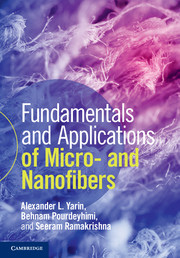Book contents
- Frontmatter
- Contents
- Preface
- 1 Introduction
- 2 Polymer physics and rheology
- 3 General quasi-one-dimensional equations of dynamics of free liquid jets, capillary and bending instability
- 4 Melt- and solution blowing
- 5 Electrospinning of micro- and nanofibers
- 6 Additional methods and materials used to form micro- and nanofibers
- 7 Tensile properties of micro- and nanofibers
- 8 Post-processing
- 9 Applications of micro- and nanofibers
- 10 Military applications of micro- and nanofibers
- 11 Applications of micro- and nanofibers, and micro- and nanoparticles: healthcare, nutrition, drug delivery and personal care
- Subject Index
- References
2 - Polymer physics and rheology
Published online by Cambridge University Press: 05 June 2014
- Frontmatter
- Contents
- Preface
- 1 Introduction
- 2 Polymer physics and rheology
- 3 General quasi-one-dimensional equations of dynamics of free liquid jets, capillary and bending instability
- 4 Melt- and solution blowing
- 5 Electrospinning of micro- and nanofibers
- 6 Additional methods and materials used to form micro- and nanofibers
- 7 Tensile properties of micro- and nanofibers
- 8 Post-processing
- 9 Applications of micro- and nanofibers
- 10 Military applications of micro- and nanofibers
- 11 Applications of micro- and nanofibers, and micro- and nanoparticles: healthcare, nutrition, drug delivery and personal care
- Subject Index
- References
Summary
Several physical concepts that are of the utmost importance in fiber-forming processes are described in this chapter. The basic physical model of a flexible polymer macromolecule as a random walk is outlined in Section 2.1. The elongational and shear rheometry of polymer solutions and melts, which elucidate the stress relation with strains and strain rate, as well as stress relaxation is described in Section 2.2. The phenomenological rheological constitutive equations appropriate for the description of viscoelastic polymer solutions and melts are introduced in Section 2.3. The micromechanical foundations of the entropic elasticity responsible for viscoelasticity of polymer solutions and melts are sketched out in Section 2.4. Solidification and crystallization are discussed in Sections 2.5 and 2.6, respectively.
Polymer structure, macromolecular chains, Kuhn segment, persistence length
A linear polymer macromolecule can be represented as a succession of identical rigid segments connected at arbitrary angles, i.e. freely jointed with each other (Flory 1969, de Gennes 1979, Doi and Edwards (1986). Such a macromolecule is comprised of N segments, each of length b. The total length of a fully stretched macromolecule is then L = Nb. The rigid segments are called Kuhn segments. A real macromolecular chain consisting of n monomers is idealized as a random walk of N Kuhn segments, which are not monomers, nor is N identical to the degree of polymerization n. If the number of Kuhn segments in a macromolecule is not large, i.e. N is close to 1, it is rather inflexible, almost rod-like. On the other hand, if N >> 1, the macromolecule is very flexible, and on length scales that are significant compared to b, but much smaller than L, it can be viewed as a flexible string. Persistence length is another length scale that characterizes the resistance of segments of macromolecular chains to bending. It is of the same order of magnitude as the length of the Kuhn segments.
Information
- Type
- Chapter
- Information
- Fundamentals and Applications of Micro- and Nanofibers , pp. 25 - 62Publisher: Cambridge University PressPrint publication year: 2014
